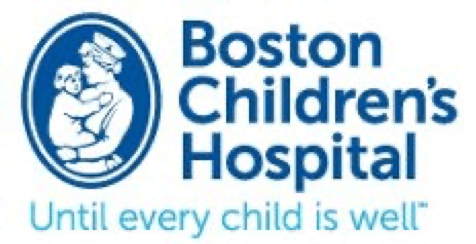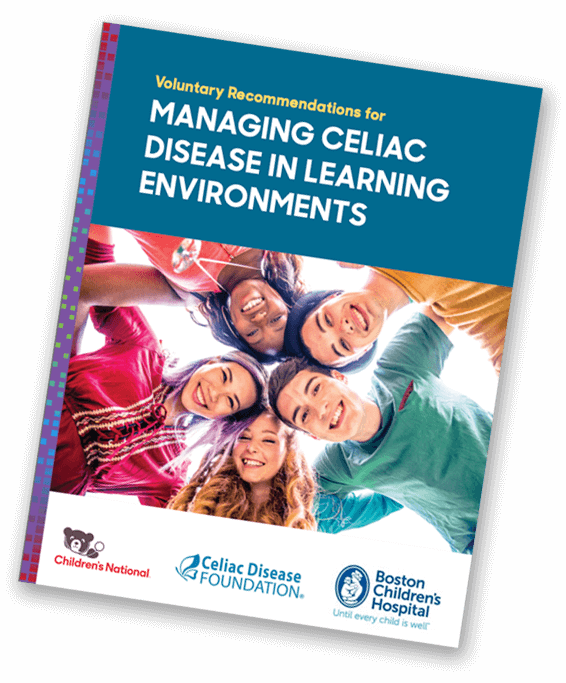Patient & Family Support for Managing Celiac Disease at School
2020 Recommendations for
Managing Children with Celiac Disease in Learning Environments
Managing the gluten-free diet at school is something that every parent of a child with celiac disease must think about. The good news is that there are new national recommendations to help!
To create one standardized set of recommendations that appropriately apply federal laws, a coalition of 46 experts convened to develop the 2020 Recommendations for Managing Children with Celiac Disease in Learning Environments. Among these experts were healthcare providers from 10 children’s hospitals (physicians, nurses, dietitians, psychologists, social workers and community education specialists); national education associations; patient, and physician advocacy groups; teachers and administrators from public and private schools; parents of children with celiac disease; students with celiac disease; a lawyer with expertise in education law; and a gluten-free food manufacturer.
The recommendations were developed to be applicable in a wide range of learning environments including public schools, private schools, charter schools, day care centers, in-home daycares, and institutions that do and do not receive federal funding.



Boston Children’s Hospital School Support Services
Schedule a visit with our Boston Children’s Celiac team to discuss celiac disease accommodations in school. There are several federal laws that public schools and those that receive federal funding are required to follow including the Americans with Disabilities Act and Section 504 of the Rehabilitation Act. Most private schools also have a formal documentation plan process to manage the needs of a child with celiac disease.
Our team can work with you and your child’s school to set up a plan to ensure a safe and inclusive school year.
How Can You Help Your Child Attend School Safely?
1.
Read a copy of the 2020 Voluntary Recommendations for Managing Celiac Disease in Learning Environments.
This document has all of the relevant information, as well as action lists for parents/guardians and kids with celiac disease.
2.
Learn about federal laws and regulations that govern celiac disease.
If you’re not knowledgeable about these laws, it will be tough to advocate for coverage under them.
3.
Get your child’s diagnosis letter from the diagnosing physician.
You will not be able to begin to get accommodations at school without this letter, so gently nudge your provider to write and sign this document as soon as possible.
4.
Think about the types of accommodations your child might want at school.
Use the list on pages 20-21 of the 2020 Voluntary Recommendations for Managing Celiac Disease in Learning Environments to start building a list of accommodations that you want to ask the school for. It’s helpful to go into meetings with the school with an idea for what your child might need.
5.
Talk to your child about the accommodation plan.
Do they want to eat lunch in the school cafeteria or bring from home? Is there a person they feel comfortable approaching if they are feeling sick or having a problem? What types of materials are they using in class? It’s important that your child is a part of this conversation so that they know what’s available to them and actually use the tools that are put into place.
6.
Schedule a meeting with our Boston Children’s Hospital School Support Team!
Watch: SAGE Training Program Videos
Introduction
Celiac disease is a common autoimmune condition that affects approximately 1 percent of children in the United States, most of whom attend federal and state-supported learning programs every weekday. When patients with celiac disease eat gluten (a protein found in wheat, rye, and barley), this stimulates the immune system to attack itself, leading to inflammation and damage to the nutrient-absorbing villi in the small intestine.
What is Celiac Disease?
In this training video, physicians affiliated with pediatric celiac disease centers will provide an overview of celiac disease and important information for managing a child living with this condition.
The Gluten-Free Diet
In this training video, nutrition experts affiliated with pediatric celiac disease centers and some children with celiac disease will provide an overview of the gluten-free diet. They will discuss selecting gluten-free food products, reading food labels, and preventing gluten cross-contact.
Supporting Social Emotional Development of Children With Celiac Disease
In this training video, our experts will discuss the impact of celiac disease on learning and social emotional development and offer tools to help fully integrate children with celiac disease into all learning environment activities.
Federal Laws and Regulations that Govern Celiac Disease
In this training video, our experts will explain several federal laws that apply to children with celiac disease and how to apply these rules in learning environments.
Where is Gluten Found in Schools
Gluten is a protein in wheat, rye, and barley. While it’s most commonly found in food, gluten is also used in many other items, including school supplies such as modeling clay, paper mâché, art supplies, glue, and ingredients used in home economics classrooms. This video highlights common places for gluten cross-contact in learning environments and presents strategies to mitigate the risk of gluten exposure for children with celiac disease.
For Medical Providers Who Diagnose and Manage Children with Celiac Disease
This video outlines how a medical provider can prepare a family with celiac disease for navigating a learning environment and setting up appropriate accommodations. Ahead you’ll see a series of role play interactions between a medical provider and patient family to help deepen your understanding of how to have these often difficult conversations.
Families with Celiac Disease: What to Expect at School
Whether your child was recently diagnosed with celiac disease or you’ve experienced conflict with the gluten-free diet in a learning environment, this training session will provide a step-by-step guide for parents and guardians of children with celiac disease to plan for a safe year in a at school.
For Learning Environment Staff Managing Celiac Disease
Learning environment professionals must often simultaneously manage and provide accommodations for students with a variety of different health conditions, including celiac disease. This brief training video outlines key strategies to methodically provide for a safe learning environment for children with celiac disease.
Food Service Providers Training
If the transfer of bacteria from raw chicken to other foods can be prevented, then transfer of gluten to gluten-free foods can also be avoided. This training video highlights areas of concern for gluten cross-contact in shared kitchens and offers strategies for food purchasing, storage, and handling to prepare gluten-free meals for children with celiac disease.
Pathway to a Celiac Disease Management Plan
This video offers a roadmap to setting up an accommodation plan for a child with celiac disease in any learning environment.
